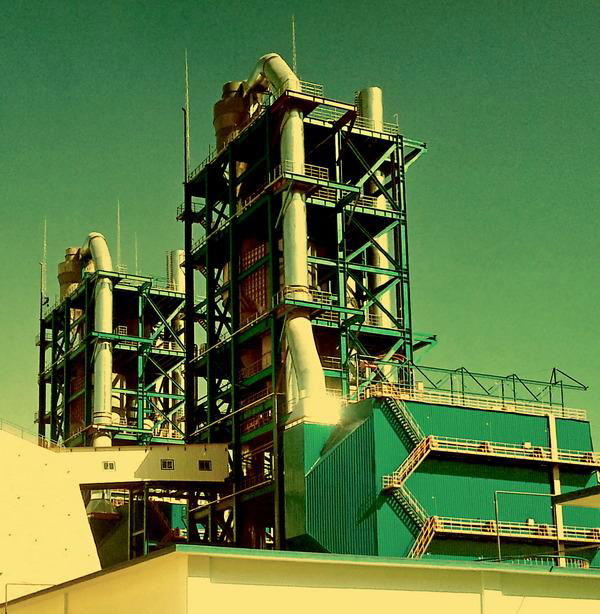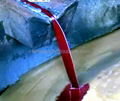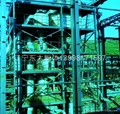| Model: | - |
|---|---|
| Brand: | DDFT |
| Origin: | Made In China |
| Category: | Industrial Supplies / Mining Machine |
| Label: | Calcined magnesite , Calcined magnesia , Suspension furnace |
| Price: |
-
|
| Min. Order: | - |
Product Description
Equipment technology of magnesite powder light burning magnesia flash swirling dynamic calcining furnace system
Low-grade magnesite ore (MgCO3) (crushed ore) is prone to under-burning or over-burning, and the quality of magnesium oxide products is unstable. Our company uses a suspension furnace to calcine low-grade magnesite ore to obtain high-quality magnesium oxide products. First, the magnesite ore is finely ground to a particle size of 75 to 10 μm, sent to a suspension furnace, and calcined at a high temperature (800 ° C - 1000 ° C), and the quality of the magnesium oxide product is stable.
The equipment consists of calcining system for heating, drying, preheating, calcination, heat exchange, collection, cooling, waste heat utilization, warehousing and packaging continuous production, which fully reflects the superior performance of energy saving and environmental protection and the high quality stability of the product.
Description and characteristics of working principle of flash swirling dynamic calciner system
SKDS flash cyclone dynamic calciner system mainly consists of heating gas hot blast stove, dryer, preheater, calciner main body, cyclone dust collector, gas-liquid heat exchanger, bag filter, wind cooling, blower, induced draft fan , thermometer, pressure gauge and pipeline, electronic control system.
The calcining heat source adopts a combustion gas or natural gas hot air furnace; firstly, the residual heat of the calcining furnace is introduced into the rotary flash drying main machine; the wet material is continuously conveyed into the drying host through the screw feeder, under the combined action of the rotating blades of the main machine and the high-speed hot air flow. The wet material is quickly dispersed into a powder to expand the evaporation area, and the material and the hot air are subjected to high-speed mass transfer and heat transfer, and the water molecules are vaporized and evaporated instantaneously, and dried and dehydrated to ≤1 to 0.5%, which is completed in about 3 to 5 seconds. During the drying process, the material that has recovered the original particle size and moisture requirements passes through the upper classification ring inside the main machine, and enters the cyclone dust collector and the bag filter together with the dry exhaust gas for gas-solid separation, and the exhaust gas after purification by the bag filter is controlled by the high pressure phoenix machine. Leading out; perfecting the uniformity of particle size by dispersing and drying, facilitating the subsequent calcination and thermal decomposition of the next step, improving the fluidity and dispersibility of the dry powder material, which is discharged by the dust collector and then enters the preheater, The material is heated to about 300-400 ° C, and continuously conveyed into the flash-rotating flow dynamic calcining furnace, and the powder is instantly dispersed by the high-temperature airflow in the furnace to form The maximum specific surface area, the particles are fully thermally decomposed in a rotating upward gas flow from 950 ° C to 1000 ° C. The particles release CO 2 and crystal water instantaneously at high temperature, decompose into magnesia as multi-aperture particles, and complete the calcination process in 3 to 5 seconds. The material enters the gas-solid separator from the outlet of the calciner with the negative pressure gas flow, and the separated powder enters the indirect heat exchange clinker, which is discharged by the discharge valve, and the hot clinker enters the negative pressure air cooling system to cool the material to 60~80 °C enters the storage bin; the residual heat of the calciner is introduced into the preheater and the dryer.
In summary, the technical features; the flash swirl dynamic calciner system is a fully enclosed negative pressure operation, no dust leakage, full gas-solid mixing, sufficient thermal decomposition, instant calcination, no over-burning of the product, is conducive to Highly active product production, product recovery rate of up to 99.9%, continuous production, calcination temperature, air volume, feeding machine speed can be adjusted, product quality is stable, working environment meets national environmental protection requirements, the machine system sets gas-gas heat exchange tripod, change The hot air can be supplied to the secondary air of the combustion chamber, and the residual heat of the calciner is combined with the preheater and the dryer to fully utilize the heat source to form an efficient energy-saving device.
The calcination system technology has been successfully applied in China: magnesium carbonate, magnesium hydroxide, magnesium oxide powder, magnesite powder, dolomite powder, nano calcium carbonate, nano zinc oxide, ultrafine white carbon black, precipitated barium sulfate, five Vanadium oxide, nickel oxide powder, cobalt oxide powder, molybdenum oxide powder, alumina powder, calcium oxide powder, boron fine powder, iron ore fine powder, rutile titanium dioxide, silicon micropowder, barite powder, limestone powder, coal gangue powder, Kaolin, bentonite, bauxite, diatomaceous earth, etc.
Low-grade magnesite ore (MgCO3) (crushed ore) is prone to under-burning or over-burning, and the quality of magnesium oxide products is unstable. Our company uses a suspension furnace to calcine low-grade magnesite ore to obtain high-quality magnesium oxide products. First, the magnesite ore is finely ground to a particle size of 75 to 10 μm, sent to a suspension furnace, and calcined at a high temperature (800 ° C - 1000 ° C), and the quality of the magnesium oxide product is stable.
The equipment consists of calcining system for heating, drying, preheating, calcination, heat exchange, collection, cooling, waste heat utilization, warehousing and packaging continuous production, which fully reflects the superior performance of energy saving and environmental protection and the high quality stability of the product.
Description and characteristics of working principle of flash swirling dynamic calciner system
SKDS flash cyclone dynamic calciner system mainly consists of heating gas hot blast stove, dryer, preheater, calciner main body, cyclone dust collector, gas-liquid heat exchanger, bag filter, wind cooling, blower, induced draft fan , thermometer, pressure gauge and pipeline, electronic control system.
The calcining heat source adopts a combustion gas or natural gas hot air furnace; firstly, the residual heat of the calcining furnace is introduced into the rotary flash drying main machine; the wet material is continuously conveyed into the drying host through the screw feeder, under the combined action of the rotating blades of the main machine and the high-speed hot air flow. The wet material is quickly dispersed into a powder to expand the evaporation area, and the material and the hot air are subjected to high-speed mass transfer and heat transfer, and the water molecules are vaporized and evaporated instantaneously, and dried and dehydrated to ≤1 to 0.5%, which is completed in about 3 to 5 seconds. During the drying process, the material that has recovered the original particle size and moisture requirements passes through the upper classification ring inside the main machine, and enters the cyclone dust collector and the bag filter together with the dry exhaust gas for gas-solid separation, and the exhaust gas after purification by the bag filter is controlled by the high pressure phoenix machine. Leading out; perfecting the uniformity of particle size by dispersing and drying, facilitating the subsequent calcination and thermal decomposition of the next step, improving the fluidity and dispersibility of the dry powder material, which is discharged by the dust collector and then enters the preheater, The material is heated to about 300-400 ° C, and continuously conveyed into the flash-rotating flow dynamic calcining furnace, and the powder is instantly dispersed by the high-temperature airflow in the furnace to form The maximum specific surface area, the particles are fully thermally decomposed in a rotating upward gas flow from 950 ° C to 1000 ° C. The particles release CO 2 and crystal water instantaneously at high temperature, decompose into magnesia as multi-aperture particles, and complete the calcination process in 3 to 5 seconds. The material enters the gas-solid separator from the outlet of the calciner with the negative pressure gas flow, and the separated powder enters the indirect heat exchange clinker, which is discharged by the discharge valve, and the hot clinker enters the negative pressure air cooling system to cool the material to 60~80 °C enters the storage bin; the residual heat of the calciner is introduced into the preheater and the dryer.
In summary, the technical features; the flash swirl dynamic calciner system is a fully enclosed negative pressure operation, no dust leakage, full gas-solid mixing, sufficient thermal decomposition, instant calcination, no over-burning of the product, is conducive to Highly active product production, product recovery rate of up to 99.9%, continuous production, calcination temperature, air volume, feeding machine speed can be adjusted, product quality is stable, working environment meets national environmental protection requirements, the machine system sets gas-gas heat exchange tripod, change The hot air can be supplied to the secondary air of the combustion chamber, and the residual heat of the calciner is combined with the preheater and the dryer to fully utilize the heat source to form an efficient energy-saving device.
The calcination system technology has been successfully applied in China: magnesium carbonate, magnesium hydroxide, magnesium oxide powder, magnesite powder, dolomite powder, nano calcium carbonate, nano zinc oxide, ultrafine white carbon black, precipitated barium sulfate, five Vanadium oxide, nickel oxide powder, cobalt oxide powder, molybdenum oxide powder, alumina powder, calcium oxide powder, boron fine powder, iron ore fine powder, rutile titanium dioxide, silicon micropowder, barite powder, limestone powder, coal gangue powder, Kaolin, bentonite, bauxite, diatomaceous earth, etc.
| Advantages: | Equipment technology of magnesite powder light burning magnesia flash swirling dynamic calcining furnace system Low-grade magnesite ore (MgCO3) (crushed ore) is prone to under-burning or over-burning, and the quality of magnesium oxide products is unstable. Our company uses a suspension furnace to calcine low-grade magnesite ore to obtain high-quality magnesium oxide products. First, the magnesite ore is finely ground to a particle size of 75 to 10 μm, sent to a suspension furnace, and calcined at a high temperature (800 ° C - 1000 ° C), and the quality of the magnesium oxide product is stable. The equipment consists of calcining system for heating, drying, preheating, calcination, heat exchange, collection, cooling, waste heat utilization, warehousing and packaging continuous production, which fully reflects the superior performance of energy saving and environmental protection and the high quality stability of the product. |
|---|---|
Member Information
| LIAONING DONGDA DRYING & CALCINATING EQUIPMENT CO., LTD. | |
|---|---|
| Country/Region: | Liao Ning - China |
| Business Nature: | Manufacturer |
| Phone: | 13998171597 |
| Contact: | Guan Yanguang (Manager) |
| Last Online: | 03 Oct, 2019 |














